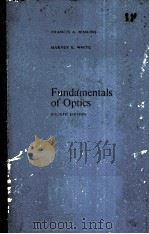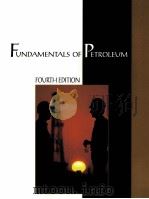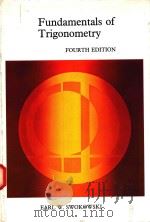《Fundamentals of Optics FOURTH EDITION》
| 作者 | FRANCIS A. JENKINS HARVEY E. 编者 |
|---|---|
| 出版 | 未查询到或未知 |
| 参考页数 | 746 |
| 出版时间 | 没有确切时间的资料 目录预览 |
| ISBN号 | 0070323305 — 求助条款 |
| PDF编号 | 812106038(仅供预览,未存储实际文件) |
| 求助格式 | 扫描PDF(若分多册发行,每次仅能受理1册) |

Part One Geometrical Optics1
1 Properties of Light3
1.1 The Rectilinear Propagation of Light5
1.2 The Speed of Light6
1.3 The Speed of Light in Stationary Matter8
1.4 The Refractive Index9
1.5 Optical Path10
1.6 Laws of Reflection and Refraction11
1.7 Graphical Construction for Refraction13
1.8 The Principle of Reversibility14
1.9 Fermat's Principle14
1.10 Color Dispersion18
2 Plane Surfaces and Prisms24
2.1 Parallel Beam24
2.2 The Critical Angle and Total Reflection25
2.3 Plane-Parallel Plate28
2.4 Refraction by a Prism29
2.5 Minimum Deviation30
2.6 Thin Prisms32
2.7 Combinations-of Thin Prisms32
2.8 Graphical Method of Ray Tracing33
2.9 Direct-Vision Prisms34
2.10 Reflection of Divergent Rays36
2.11 Refraction of Divergent Rays36
2.12 Images Formed by Paraxial Rays38
2.13 Fiber Optics40
3 Spherical Surfaces44
3.1 Focal Points and Focal Lengths45
3.2 Image Formation46
3.3 Virtual Images47
3.4 Conjugate Points and Planes47
3.5 Convention of Signs50
3.6 Graphical Constructions. The Parallei-Ray Method50
3.7 Oblique-Ray Methods52
3.8 Magnification54
3.9 Reduced Vergence54
3.10 Derivation of the Gaussian Formula56
3.11 Nomography57
4 Thin Lenses60
4.1 Focal Points and Focal Lengths60
4.2 Image Formation62
4.3 Conjugate Points and Planes62
4.4 The Parallel-Ray Method62
4.5 The Oblique-Ray Method63
4.6 Use of the Lens Formula64
4.7 Lateral Magnification64
4.8 Virtual Images65
4.9 Lens Makers' Formula67
4.10 Thin-Lens Combinations68
4.11 Object Space and Image Space70
4.12 The Power of a Thin Lens70
4.13 Thin Lenses in Contact71
4.14 Derivation of the Lens Formula72
4.15 Derivation of the Lens Makers'Formula73
5 Thick Lenses78
5.7 Two Spherical Surfaces78
5.2 The Parallel-Ray Method79
5.3 Focal Points and Principal Points81
5.4 Conjugate Relations82
5.5 The Oblique-Ray Method82
5.6 General Thick-Lens Formulas84
5.7 Special Thick Lenses88
5.8 Nodal Points and Optical Center88
5.9 Other Cardinal Points90
5.10 Thin-Lens Combination as a Thick Lens91
5.11 Thick-Lens Combinations93
5.12 Nodal Slide93
6 Spherical Mirrors98
6.1 Focal Point and Focal Length98
6.2 Graphical Constructions99
6.3 Mirror Formulas102
6.4 Power of Mirrors104
6.5 Thick Mirrors105
6.6 Thick-Mirror Formulas107
6.7 Other Thick Mirrors109
6.8 Spherical Aberration109
6.9 Astigmatism111
7 The Effects of Stops115
7.1 Field Stop and Aperture Stop115
7.2 Entrance and Exit Pupils116
7.3 Chief Ray117
7.4 Front Stop117
7.5 Stop between Two Lenses118
7.6 Two Lenses with No Stop120
7.7 Determination of the Aperture Stop121
7.8 Field of View122
7.9 Field of a Plane Mirror122
7.10 Field of a Convex Mirror124
7.11 Field of a Positive Lens124
8 Ray Tracing130
8.1 Oblique Rays130
8.2 Graphical Method for Ray Tracing131
8.3 Ray-tracing Formulas134
8.4 Sample Ray-tracing Calculations135
9 Lens Aberrations149
9.1 Expansion of the Sine. First-Order Theory150
9.2 Third-Order Theory of Aberrations151
9.3 Spherical Aberration of a Single Surface152
9.4 Spherical Aberration of a Thin Lens153
9.5 Results of Third-Order Theory157
9.6 Fifth-Order Spherical Aberration160
9.7 Coma162
9.8 Aplanatic Points of a Spherical Surface166
9.9 Astigmatism167
9.10 Curvature of Field170
9.11 Distortion171
9.12 The Sine Theorem and Abbe's Sine Condition173
9.13 Chromatic Aberration176
9.14 Separated Doublet182
10 Optical Instruments188
10.1 The Human Eye188
10.2 Cameras and Photographic Objectives191
10.3 Speed of Lenses191
10.4 Meniscus Lenses193
10.5 Symmetrical Lenses193
10.6 Triplet Anastigmats194
10.7 Telephoto Lenses195
10.8 Magnifiers195
10.9 Types of Magnifiers198
10.10 Spectacle Lenses198
10.11 Microscopes200
10.12 Microscope Objectives201
10.13 Astronomical Telescopes202
10.14 Oculars and Eyepieces205
10.15 Huygens Eyepiece205
10.16 Ramsden Eyepiece206
10.17 Kellner or Achromatized Ramsden Eyepiece206
10.18 Special Eyepieces206
10.19 Prism Binoculars207
10.20 The Kellner-Schmidt Optical System208
10.21 Concentric Optical Systems209
Part Two Wave Optics213
11 Vibrations and Waves214
11.1 Simple Harmonic Motion216
11.2 The Theory of Simple Harmonic Motion217
11.3 Stretching of a Coiled Spring218
11.4 Vibrating Spring221
11.5 Transverse Waves223
11.6 Sine Waves224
11.7 Phase Angles225
11.8 Phase Velocity and Wave Velocity228
11.9 Amplitude and Intensity229
11.10 Frequency and Wavelength232
11.11 Wave Packets235
12 The Superposition of Waves238
12.1 Addition of Simple Harmonic Motions along the Same Line239
12.2 Vector Addition of Amplitudes240
12.3 Superposition of Two Wave Trains of the Same Frequency242
12.4 Superposition of Many Waves with Random Phases244
12.5 Complex Waves246
12.6 Fourier Analysis248
12.7 Group Velocity250
12.8 Graphical Relation between Wave and Group Velocity252
12.9 Addition of Simple Harmonic Motions at Right Angles253
13 Interference of Two Beams of Light259
13.1 Huygens' Principle260
13.2 Young's Experiment261
13.3 Interference Fringes from a Double Source263
13.4 Intensity Distribution in the Fringe System265
13.5 Fresnel's Biprism266
13.6 Other Apparatus Depending on Division of the Wave Front268
13.7 Coherent Sources270
13.8 Division of Amplitude. Michelson Interferometer271
13.9 Circular Fringes273
13.10 Localized Fringes275
13.11 White-Light Fringes276
13.12 Visibility of the Fringes277
13.13 Interferometnc Measurements of Length279
13.14 Twyman and Green Interferometer281
13.15 Index of Refraction by Interference Methods282
14 Interference Involving Multiple Reflections286
14.1 Reflection from a Plane-Parallel Film288
14.2 Fringes of Equal Inclination291
14.3 Interference in the Transmitted Light292
14.4 Fringes of Equal Thickness293
14.5 Newton's Rings294
14.6 Nonreflecting Films295
14.7 Sharpness of the Fringes297
14.8 Method of Complex Amplitudes299
14.9 Derivation of the Intensity Function300
14.10 Fabry-Perot Interferometer301
14.11 Brewster's Fringes302
14.12 Chromatic Resolving Power303
14.13 Comparison of Wavelengths with the Interferometer305
14.14 Study of Hyperfine Structure and of Line Shape308
14.15 Other Interference Spectroscopes310
14.16 Channeled Spectra. Interference Filter311
15 Fraunhofer Diffraction by a Single Opening315
15.1 Fresnel and Fraunhofer Diffraction315
15.2 Diffraction by a Single Slit316
15.3 Further Investigation of the Single-Slit Diffraction Pattern319
15.4 Graphical Treatment of Amplitudes. The Vibration Curve322
15.5 Rectangular Aperture324
15.6 Resolving Power with a Rectangular Aperture325
15.7 Chromatic Resolving Power of a Prism327
15.8 Circular Aperture329
15.9 Resolving Power of a Telescope330
15.10 Resolving Power of a Microscope332
15.11 Diffraction Patterns with Sound and Microwaves334
16 The Double Slit338
16.1 Qualitative Aspects of the Pattern338
16.2 Derivation of the Equation for the Intensity339
16.3 Comparison of the Single-Slit and Double-Slit Patterns341
16.4 Distinction between Interference and Diffraction341
16.5 Position of the Maxima and Minima. Missing Orders342
16.6 Vibration Curve346
16.7 Effect of Finite Width of Source Slit347
16.8 Michelson's Stellar Interferometer349
16.9 Correlation Interferometer351
16.10 Wide-Angle Interference352
17 The Diffraction Grating355
17.1 Effect of Increasing the Number of Slits355
17.2 Intensity Distribution from an Ideal Grating357
17.5 Principal Maxima358
17.4 Minima and Secondary Maxima358
17.5 Formation of Spectra by a Grating359
17.6 Dispersion362
17.7 Overlapping of Orders362
17.8 Width of the Principal Maxima363
17.9 Resolving Power364
17.10 Vibration Curve365
17.11 Production of Ruled Gratings368
17.12 Ghosts370
17.13 Control of the Intensity Distribution among Orders370
17.14 Measurement of Wavelength with the Grating373
17.15 Concave Grating373
17.16 Grating Spectrographs374
18 Fresnel Diffraction378
18.1 Shadows378
18.2 Fresnel's Half-Period Zones380
18.3 Diffraction by a Circular Aperture383
18.4 Diffraction by a Circular Obstacle384
18.5 Zone Plate385
18.6 Vibration Curve for Circular Division of the Wave Front386
18.7 Apertures and Obstacles with Straight Edges388
18.8 Strip Division of the Wave Front389
18.9 Vibration Curve for Strip Division. Cornu's Spiral389
18.10 Fresnel's Integrals390
18.11 The Straight Edge393
18.12 Rectilinear Propagation of Light395
18.13 Single Slit397
18.14 Use of Fresnel's Integrals in Solving Diffraction Problems399
18.15 Diffraction by an Opaque Strip400
19 The Speed of Light403
19.1 Romer's Method403
19.2 Bradley's Method. The Aberration of Light405
19.3 Michelson's Experiments406
19.4 Measurements in a Vacuum408
19.5 Kerr-Cell Method408
19.6 Speed of Radio Waves410
19.7 Ratio of the Electrical Units411
19.8 The Speed of Light in Stationary Matter411
19.9 Speed of Light in Moving Matter412
19.10 Fresnel's Dragging Coefficient413
19.11 Airy's Experiment414
19.12 Effect of Motion of the Observer414
19.13 The Michelson-Morley Experiment416
19.14 Principle of Relativity418
19.15 The Three First-Order Relativity Effects419
20 The Electromagnetic Character of Light423
20.1 Transverse Nature of Light Vibrations424
20.2 Maxwell's Equations for a Vacuum424
20.3 Displacement Current425
20.4 The Equations for Plane Electromagnetic Waves427
20.5 Pictorial Representation of an Electromagnetic Wave428
20.6 Light Vector in an Electromagnetic Wave429
20.7 Energy and Intensity of the Electromagnetic Wave429
20.8 Radiation from an Accelerated Charge430
20.9 Radiation From a Charge in Periodic Motion432
20.10 Hertz's Verification of the Existence of Electromagnetic Waves432
20.11 Speed of Electromagnetic Waves in Free Space434
20.12 Cerenkov Radiation434
21 Sources of Light and Their Spectra438
21.1 Classification of Sources438
21.2 Solids at High Temperature439
21.3 Metallic Arcs439
21.4 Bunsen Flame442
21.5 Spark442
21.6 Vacuum Tube443
21.7 Classification of Spectra445
21.8 Emittance and Absorptance445
21.9 Continuous Spectra447
21.10 Line Spectra450
21.11 Series of Spectral Lines452
21.12 Band Spectra453
22 Absorption and Scattering457
22.1 General and Selective Absorption457
22.2 Distinction between Absorption and Scattering458
22.3 Absorption by Solids and Liquids459
22.4 Absorption by Gases461
22.5 Resonance and Fluorescence of Gases461
22.6 Fluorescence of Solids and Liquids464
22.7 Selective Reflection. Residual Rays464
22.8 Theory of the Connection between Absorption and Reflection465
22.9 Scattering by Small Particles466
22.10 Molecular Scattering468
22.11 Raman Effect469
22.12 Theory of Scattering470
22.13 Scattering and Refractive Index471
23 Dispersion474
23.1 Dispersion of a Prism474
23.2 Normal Dispersion475
23.3 Cauchy's Equation479
23.4 Anomalous Dispersion479
23.5 Sellmeier's Equation482
23.6 Effect of Absorption on Dispersion485
23.7 Wave and Group Velocity in the Medium487
23.8 The Complete Dispersion Curve of a Substance488
23.9 The Electromagnetic Equations for Transparent Media489
23.10 Theory of Dispersion491
23.11 Nature of the Vibrating Particles and Frictional Forces494
24 The Polarization of Light497
24.1 Polarization by Reflection498
24.2 Representation of the Vibrations in Light499
24.3 Polarizing Angle and Brewster's Law500
24.4 Polarization by a Pile of Plates501
24.5 Law of Malus503
24.6 Polarization by Dichroic Crystals504
24.7 Double Refraction505
24.8 Optic Axis507
24.9 Principal Sections and Principal Planes507
24.10 Polarization by Double Refraction508
24.11 Nicol Prism510
24.12 Parallel and Crossed Polarizers511
24.13 Refraction by Calcite Prisms511
24.14 Rochon and Wollaston Prisms513
24.15 Scattering of Light and the Blue Sky514
24.16 The Red Sunset515
24.17 Polarization by Scattering516
24.18 The Optical Properties of Gemstones518
25 Reflection523
25.1 Reflection from Dielectrics523
25.2 Intensities of the Transmitted Light526
25.3 Internal Reflection527
25.4 Phase Changes on Reflection527
25.5 Reflection of Plane-polarized Light from Dielectrics529
25.6 Elliptically Polarized Light by Internal Reflection531
25.7 Penetration into the Rare Medium533
25.8 Metallic Reflection534
25.9 Optical Constants of Metals536
25.10 Description of the Light Reflected from Metals538
25.11 Measurement of the Principal Angle of Incidence and Principal Azimuth540
25.12 Wiener's Experiments541
26 Double Refraction544
26.1 Wave Surfaces for Uniaxial Crystals544
26.2 Propagation of Plane Waves in Uniaxial Crystals546
26.3 Plane Waves at Oblique Incidence549
26.4 Direction of the Vibrations550
26.5 Indices of Refraction for Uniaxial Crystals551
26.6 Wave Surfaces in Biaxial Crystals553
26.7 Internal Conical Refraction556
26.8 External Conical Refraction557
26.9 Theory of Double Refraction559
27 Interference of Polarized Light564
27.1 Elliptically and Circularly Polarized Light564
27.2 Quarter- and Half-Wave Plates567
27.3 Crystal Plates between Crossed Polarizers568
27.4 Babinet Compensator569
27.5 Analysis of Polarized Light571
27.6 Interference with White Light572
27.7 Polarizing Monochromatic Filter575
27.8 Applications of Interference in Parallel Light576
27.9 Interference in Highly Convergent Light576
28 Optical Activity and Modern Wave Optics581
28.1 Rotation of the Plane of Polarization581
28.2 Rotary Dispersion582
28.3 Fresnel's Explanation of Rotation584
28.4 Double Refraction in Optically Active Crystals586
28.5 Shape of the Wave Surfaces in Quartz588
28.6 Fresnel's Multiple Prism589
28.7 Cornu Prism590
28.8 Vibration Forms and Intensities in Active Crystals591
28.9 Theory of Optical Activity593
28.10 Rotation in Liquids594
28.11 Modern Wave Optics596
28.12 Spatial Filtering597
28.13 Phase-Contrast Microscope602
28.14 Schlieren Optics604
Part Three Quantum Optics609
29 Light Quanta and Their Origin611
29.1 The Bohr Atom612
29.2 Energy Levels616
29.3 Bohr-Stoner Scheme for Building Up Atoms617
29.4 Elliptical Orbits, or Penetrating Orbitals619
29.5 Wave Mechanics622
29.6 The Spectrum of Sodium625
29.7 Resonance Radiation626
29.8 Metastable States629
29.9 Optical Pumping630
30 Lasers632
30.1 Stimulated Emission633
30.2 Laser Design634
30.3 The Ruby Laser635
30.4 The Helium-Neon Gas Laser636
30.5 Concave Mirrors and Brewster's Windows642
30.6 The Carbon Dioxide Laser643
30.7 Resonant Cavities646
30.8 Coherence Length650
30.9 Frequency Doubling652
30.10 Other Lasers653
30.11 Laser Safety653
30.12 The Speckle Effect653
30.13 Laser Applications654
31 Holography658
31.1 The Basic Principles of Holography659
31.2 Viewing a Hologram664
31.3 The Thick, or Volume, Hologram665
31.4 Multiplex Holograms669
31.5 White-Light-Reflection Holograms670
31.6 Other Holograms672
31.7 Student Laboratory Holography675
32 Magneto-Optics and Electro-Optics678
32.1 Zeeman Effect679
32.2 Inverse Zeeman Effect685
32.3 Faraday Effect686
32.4 Voigt Effect, or Magnetic Double Refraction688
32.5 Cotton-Mouton Effect690
32.6 Kerr Magneto-optic Effect691
32.7 Stark Effect691
32.8 Inverse Stark Effect692
32.9 Electric Double Refraction693
32.10 Kerr Electro-optic Effect693
32.11 Pockels Electro-optic Effect695
33 The Dual Nature of Light698
33.1 Shortcomings of the Wave Theory699
33.2 Evidence for Light Quanta700
33.3 Energy, Momentum, and Velocity of Photons703
33.4 Development of Quantum Mechanics704
33.5 Principle of Indeterminacy705
33.6 Diffraction by a Slit705
33.7 Complementarity707
33.8 Double Slit707
33.9 Determination of Position with a Microscope709
33.10 Use of a Shutter710
33.11 Interpretation of the Dual Character of Light711
33.12 Realms of Applicability of Waves and Photons712
Appendixes715
Ⅰ The Physical Constants716
Ⅱ Electron Subshells717
Ⅲ Refractive Indices and Dispersions for Optical Glasses720
Ⅳ Refractive Indices and Dispersions of Optical Crystals721
Ⅴ The Most Intense Fraunhofer Lines722
Ⅵ Abbreviated Number System723
Ⅶ Significant Figures724
Index727
《Fundamentals of Optics FOURTH EDITION》由于是年代较久的资料都绝版了,几乎不可能购买到实物。如果大家为了学习确实需要,可向博主求助其电子版PDF文件。对合法合规的求助,我会当即受理并将下载地址发送给你。
高度相关资料
-

- Fundamentals of Behavioral Statistics Fourth Edition
- Audrey Haber"
-

- SOVIET GEOGRAPHICAL EXPLORATIONS AND DESCOVERIES
- 1974 PROGRESS PUBLISGERS MOSEOW
-

- FUNDAMENTALS OF PETROLEUM FOURTH EDITION
- 1997 PETROLEUM EXTENSION SERVICE
-

- FUNDAMENTALS OF CLINICAL HEMATOLOGY FOURTH EDITION
- 1976 W.B.SAUNDERS COMPANY
-

- FUNDAMENTALS OF BIOSTATISTICS FOURTH EDITION
- 1995 DUXBURY PRESS
-

- FUNDAMENTALS OF ADVERTISING RESEARCH FOURTH EDITION
- 1991 WADSWORTH PUBLISHING COMPANY
-

- FOOD FUNDAMENTALS FOURTH EDITION
- 1986 MACMILLAN PUBLISHING COMPANY
-

- FUNDAMENTALS OF LOGIC DESIGN FOURTH EDITION
- 1995 PWS PUBLISHING COMPANY
-

- FUNDAMENTALS OF ORGANIC CHEMISTRY FOURTH EDITION
- 1998 BROOKS/COLE PUBLISHING COMPANY
-

- FUNDAMENTALS OF OPTICS SECOND EDITION
- 1953 MCGRAW-HILL PUBLISHING COMPANY LTD.
-

- Fundamentals of engineering drawing fourth edition
- 1996 Glencoe/McGraw-Hill
-

- FUNDAMENTALS OF CLINICAL ENDOCRINOLOGY FOURTH EDITION
- 1989 CHURCHILL LIVINGSTONE
-

- FUNDAMENTALS OF BUSINESS LAW FOURTH EDITION
- 1986 PRENTICE-HALL
提示:百度云已更名为百度网盘(百度盘),天翼云盘、微盘下载地址……暂未提供。➥ PDF文字可复制化或转WORD

